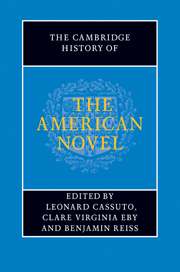Book contents
- Frontmatter
- General Introduction
- PART ONE INVENTING THE AMERICAN NOVEL
- PART TWO REALISM, PROTEST, ACCOMMODATION
- Introduction: realism, protest, accommodation
- 17 Realism and radicalism: the school of Howells
- 18 James, pragmatism, and the realist ideal
- 19 Theories of the American novel in the age of realism
- 20 The novel in postbellum print culture
- 21 Twain, class, and the Gilded Age
- 22 Dreiser and the city
- 23 Novels of civic protest
- 24 Novels of American business, industry, and consumerism
- 25 New Americans and the immigrant novel
- 26 Cather and the regional imagination
- 27 Wharton, marriage, and the New Woman
- 28 The postbellum race novel
- 29 The African American novel after Reconstruction
- 30 The rise of naturalism
- 31 Imagining the frontier
- 32 Imperialism, Orientalism, and empire
- 33 The hemispheric novel in the post-revolutionary era
- 34 The woman's novel beyond sentimentalism
- 35 Dime novels and the rise of mass-market genres
- 36 Readers and reading groups
- PART THREE MODERNISM AND BEYOND
- PART FOUR CONTEMPORARY FORMATIONS
- A selected bibliography
- Index
31 - Imagining the frontier
from PART TWO - REALISM, PROTEST, ACCOMMODATION
Published online by Cambridge University Press: 28 July 2011
- Frontmatter
- General Introduction
- PART ONE INVENTING THE AMERICAN NOVEL
- PART TWO REALISM, PROTEST, ACCOMMODATION
- Introduction: realism, protest, accommodation
- 17 Realism and radicalism: the school of Howells
- 18 James, pragmatism, and the realist ideal
- 19 Theories of the American novel in the age of realism
- 20 The novel in postbellum print culture
- 21 Twain, class, and the Gilded Age
- 22 Dreiser and the city
- 23 Novels of civic protest
- 24 Novels of American business, industry, and consumerism
- 25 New Americans and the immigrant novel
- 26 Cather and the regional imagination
- 27 Wharton, marriage, and the New Woman
- 28 The postbellum race novel
- 29 The African American novel after Reconstruction
- 30 The rise of naturalism
- 31 Imagining the frontier
- 32 Imperialism, Orientalism, and empire
- 33 The hemispheric novel in the post-revolutionary era
- 34 The woman's novel beyond sentimentalism
- 35 Dime novels and the rise of mass-market genres
- 36 Readers and reading groups
- PART THREE MODERNISM AND BEYOND
- PART FOUR CONTEMPORARY FORMATIONS
- A selected bibliography
- Index
Summary
When Wallace Stegner writes of Susan Burling Ward, the heroine of his magisterial Western novel, Angle of Repose (1971), “she knew it was a deficiency in herself that her imagination was so controlled by things,” he offers a key insight into frontier aesthetics. Like Susan, who “was often unable to get expressiveness and individuality into figures and faces” until she placed them in some setting, writers of the frontier tend to derive character, or even the category of the human, from landscape and spatial metaphor. Defined as “the line of most rapid and effective Americanization” by Frederick Jackson Turner, the frontier has functioned as a grand spatial metaphor, the line between civilization and so-called savagery, Old World and New. In the collective imaginings of the United States, the frontier has also functioned to separate the USA from global imperial history, marking it as an exceptional national experiment.
In the heyday of Euro-American Manifest Destiny, Henry David Thoreau defined the frontier as wherever we front a fact. While Thoreau appreciates the non-human aspects of the environment, including what we might call things, his gloss upon the frontier considers it as a problem of human imagination and cognition. Thoreau writes in Walden (1854) that to “stand right fronting and face to face with a fact” would be the equivalent of the sacrifice of the self to fact's “sweet edge”; fact is so radically unlike the self, in other words, that truly to comprehend a fact amounts to selfnegation. Such confrontations with non-identity dramatize the frontier experience.
- Type
- Chapter
- Information
- The Cambridge History of the American Novel , pp. 515 - 536Publisher: Cambridge University PressPrint publication year: 2011
- 1
- Cited by

